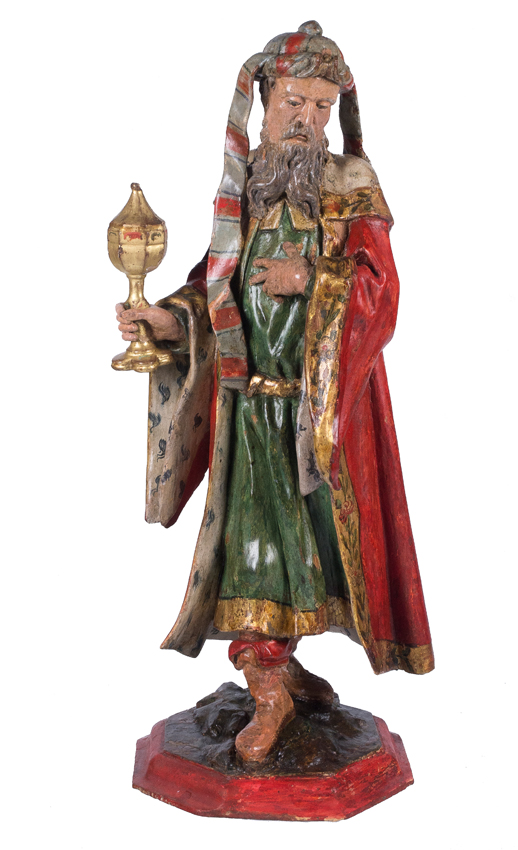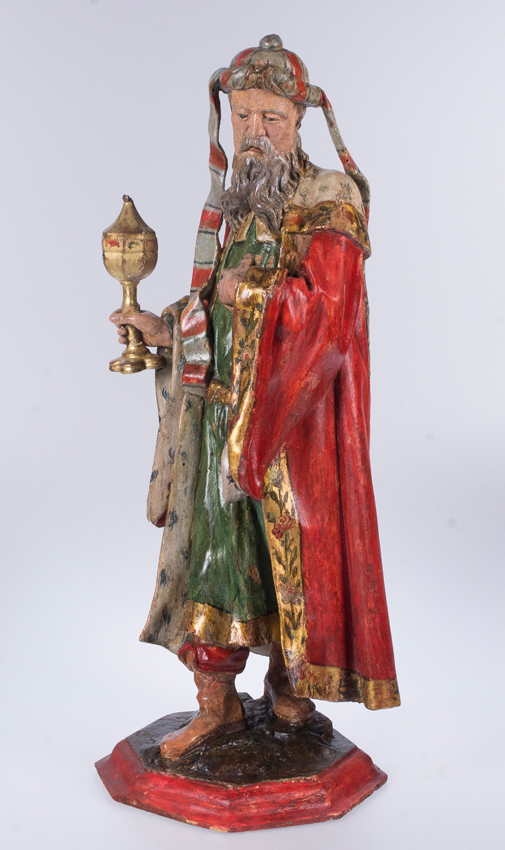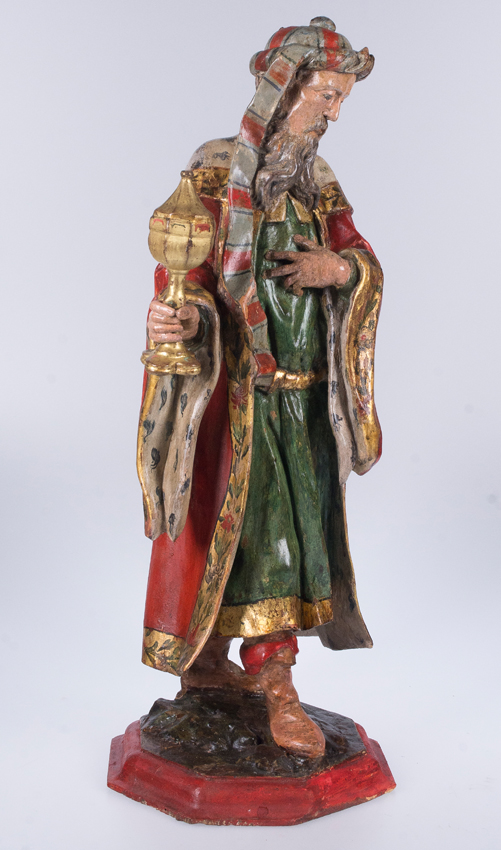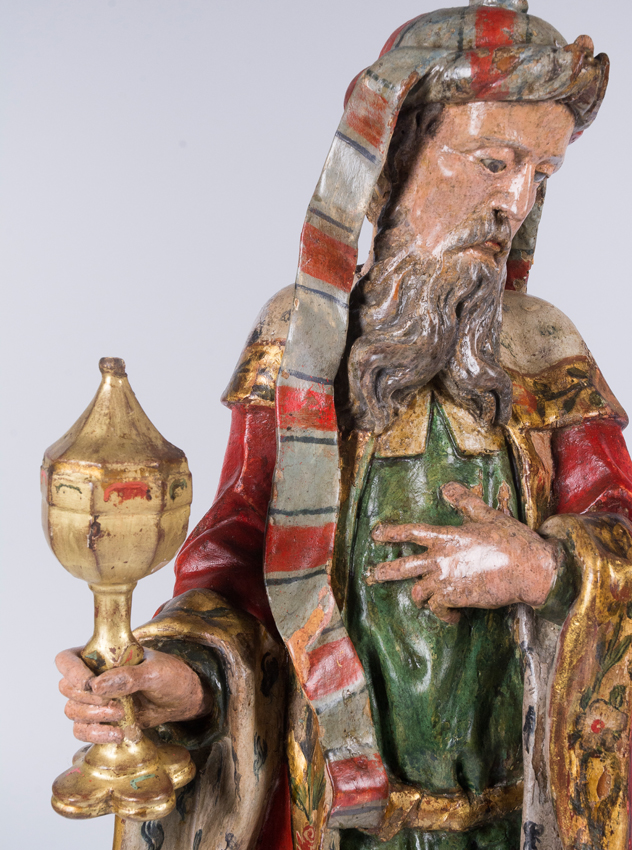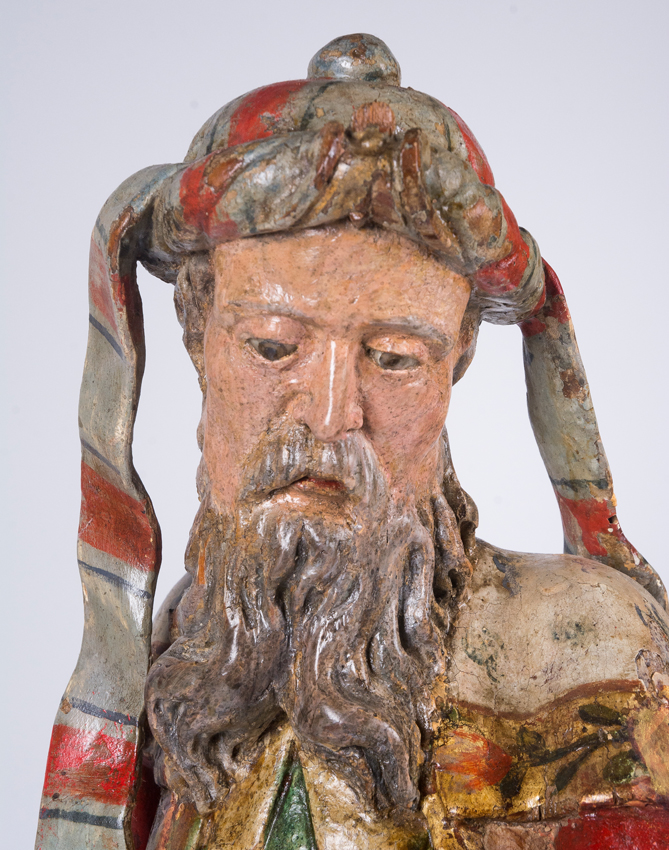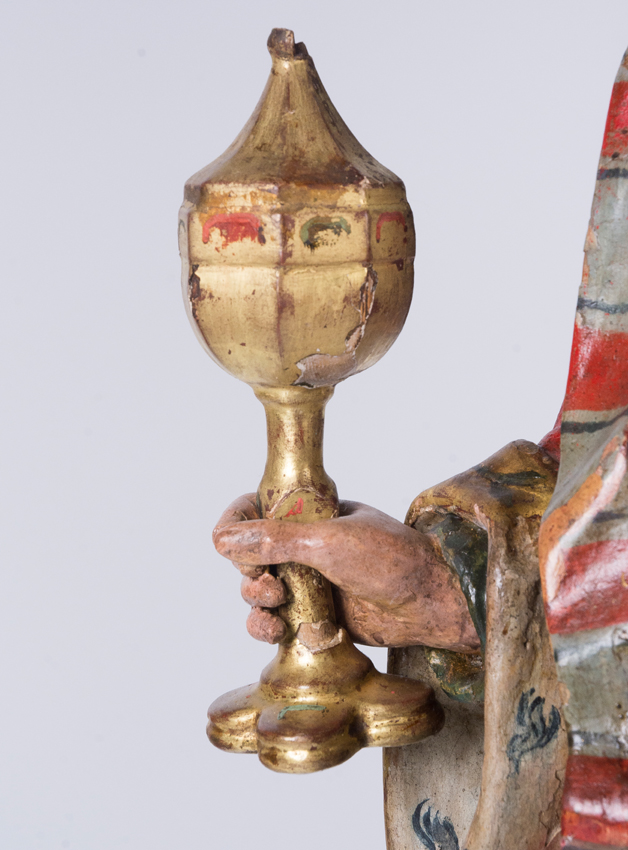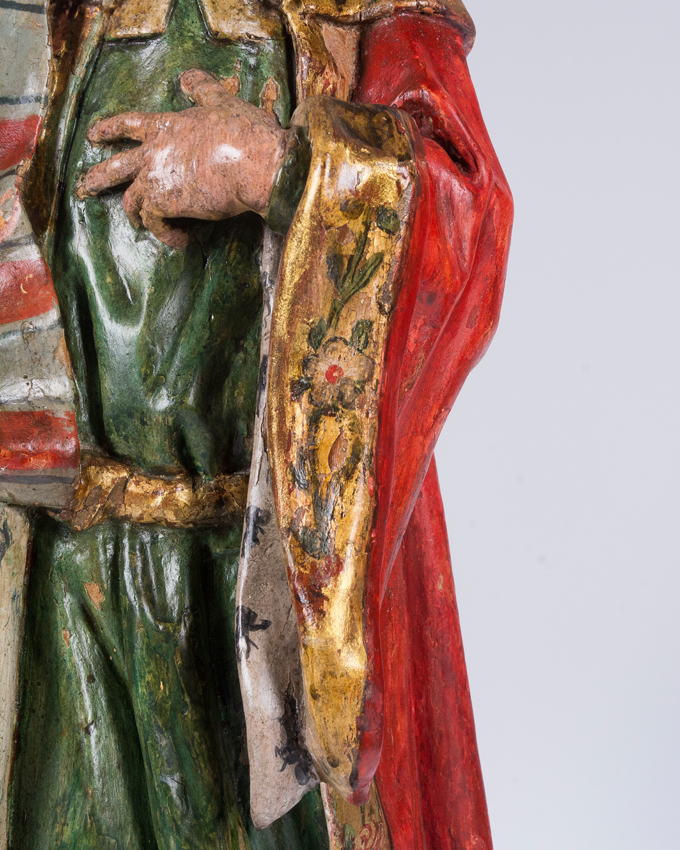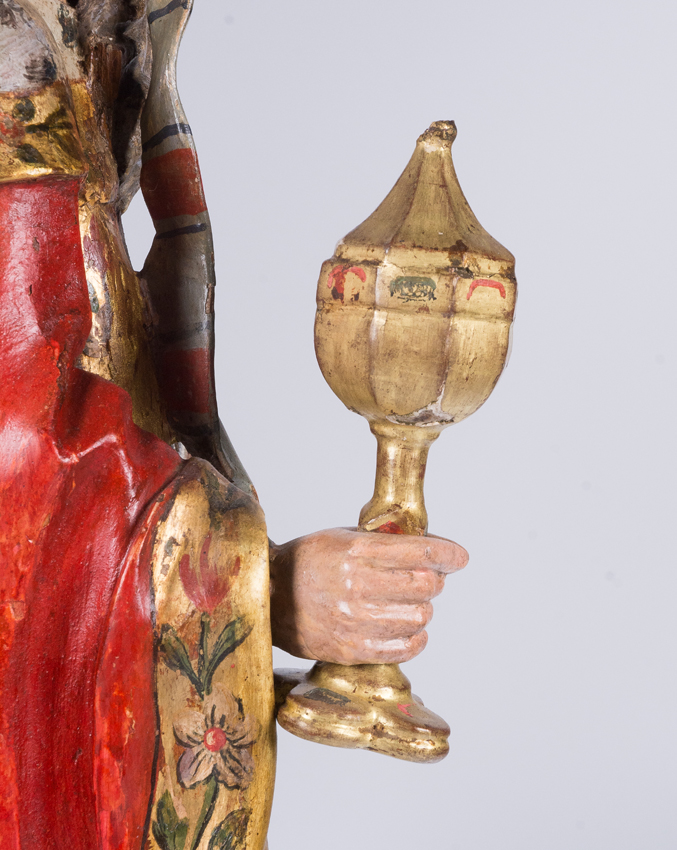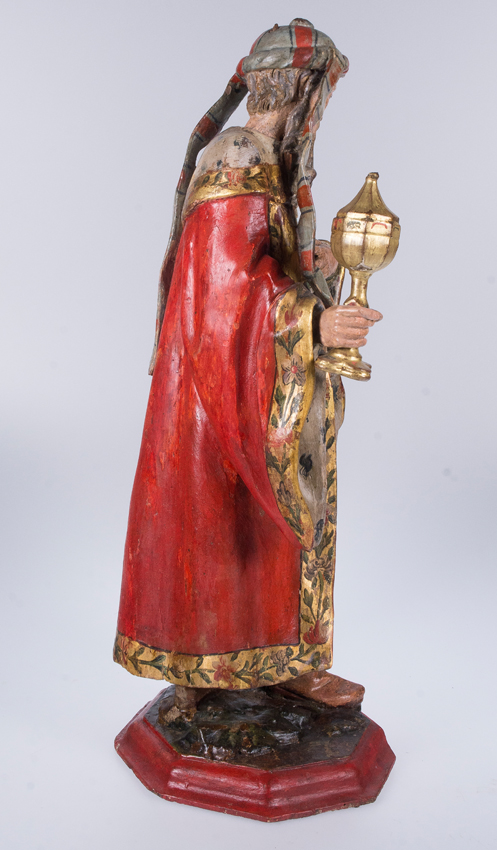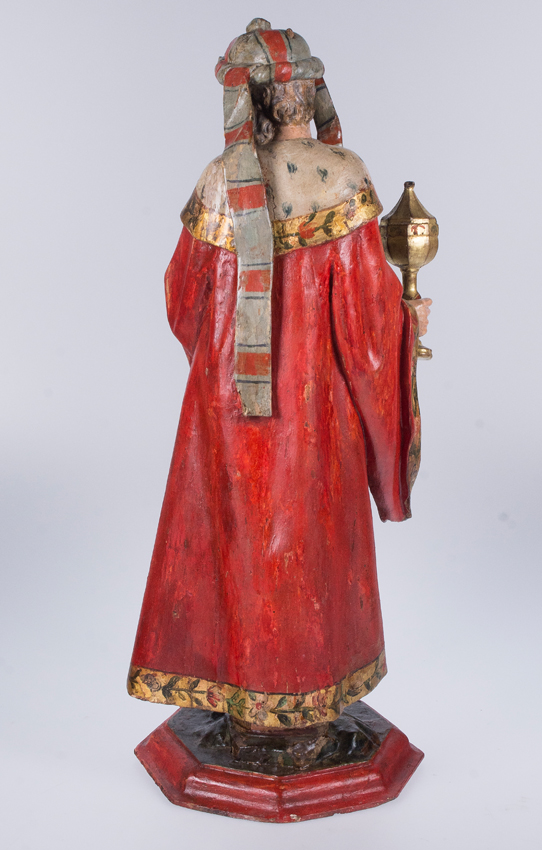14
"King Melchior". Sculpture in carved and polychromed wood. Anonymous, Castilian. Circa 1725-1750.
In Millésime 23
66 x 28 x 24 cm.
This incredible carving of King Melchior would certainly have belonged to a creche or nativity group, made in Castile in the second quarter of the 18th century. This is a truly extraordinary fact since hardly any examples of these are known of, and of the few that are, almost none of them are whole, free-standing sculptures as they are mostly dressed images which only have carved heads, hands and feet. Hence the relevance of this carving which, additionally, is of very high quality.
This effigy of King Melchior is in a standing posture, with his body forming an elegant serpentine form and, at the same time, a contrapposto, giving it remarkable dynamism through bringing the right leg forward, crossing it in front of the left. He extends his right arm, holding a closed golden goblet in his hand –reminiscent of certain models of chalices of the time– the receptacle for the gold that he gave to the Christ Child when the three kings came to adore Him in Bethlehem. The meaning of the gold is recognition of the Christ Child as the King of Kings. Melchior, places the fingertips of his left hand on his chest in an act that mixes devotion and respect for the newborn. Finally, the head, full of nobility and goodness, is slightly bent as if looking at the Child. It is an elongated head with slanted eyes painted on the wood itself and with very marked eyelids, a wide nose with a straight septum and a small mouth with fleshy lips. The ears are barely noticeable due to the hairstyle and headdress. He has short grey hair, a wide moustache and a forked and symmetrical beard, which is very long and fluffy and composed of unruly and well-defined locks. The head is covered by a curious oriental headdress from which two strips of cloth fall that resemble the infulae of bishops' mitres. He wears a long green tunic, tied at the waist and reaching to his ankles. It is cinched at the waist with a golden cincture, the same colour as a border on the lower edge and also on the turtleneck. Above it, he wears an open overtunic with wide sleeves, polychromed in an imitation of ermine on the inside – indicative of his royalty, while on the outside it is red and with the lower edge bordered in gold with plant motifs. The shoulders are covered by a kind of hood, also made of ermine, decorated with a wide border identical to the one mentioned above: golden and with stylized plant motifs.
Due to the stylistic details and facial features, the presence of the pleats and the coincidence in terms of the forms of clothing and iconography with numerous Castilian representations of Saint Joaquim dating to the mid-18th century, we believe that it was carved by a good Castilian sculptor in the second quarter of the 18th century, perhaps from Valladolid or Rio Seco, but certainly Castilian.
We thank Dr. Javier Baladrón, PhD in Art History, for identifying and cataloguing this work.
66 x 28 x 24 cm.
This incredible carving of King Melchior would certainly have belonged to a creche or nativity group, made in Castile in the second quarter of the 18th century. This is a truly extraordinary fact since hardly any examples of these are known of, and of the few that are, almost none of them are whole, free-standing sculptures as they are mostly dressed images which only have carved heads, hands and feet. Hence the relevance of this carving which, additionally, is of very high quality.
This effigy of King Melchior is in a standing posture, with his body forming an elegant serpentine form and, at the same time, a contrapposto, giving it remarkable dynamism through bringing the right leg forward, crossing it in front of the left. He extends his right arm, holding a closed golden goblet in his hand –reminiscent of certain models of chalices of the time– the receptacle for the gold that he gave to the Christ Child when the three kings came to adore Him in Bethlehem. The meaning of the gold is recognition of the Christ Child as the King of Kings. Melchior, places the fingertips of his left hand on his chest in an act that mixes devotion and respect for the newborn. Finally, the head, full of nobility and goodness, is slightly bent as if looking at the Child. It is an elongated head with slanted eyes painted on the wood itself and with very marked eyelids, a wide nose with a straight septum and a small mouth with fleshy lips. The ears are barely noticeable due to the hairstyle and headdress. He has short grey hair, a wide moustache and a forked and symmetrical beard, which is very long and fluffy and composed of unruly and well-defined locks. The head is covered by a curious oriental headdress from which two strips of cloth fall that resemble the infulae of bishops' mitres. He wears a long green tunic, tied at the waist and reaching to his ankles. It is cinched at the waist with a golden cincture, the same colour as a border on the lower edge and also on the turtleneck. Above it, he wears an open overtunic with wide sleeves, polychromed in an imitation of ermine on the inside – indicative of his royalty, while on the outside it is red and with the lower edge bordered in gold with plant motifs. The shoulders are covered by a kind of hood, also made of ermine, decorated with a wide border identical to the one mentioned above: golden and with stylized plant motifs.
Due to the stylistic details and facial features, the presence of the pleats and the coincidence in terms of the forms of clothing and iconography with numerous Castilian representations of Saint Joaquim dating to the mid-18th century, we believe that it was carved by a good Castilian sculptor in the second quarter of the 18th century, perhaps from Valladolid or Rio Seco, but certainly Castilian.
We thank Dr. Javier Baladrón, PhD in Art History, for identifying and cataloguing this work.
Millésime 23
Sale Date(s)
Venue Address
General delivery information available from the auctioneer
The purchase price includes the delivery of the lots in the venue of the auction. Transporting to other destinations is at the own risk of the client. The customer must contact "LST", to give the corresponding instructions for such transporting. "LST" is not responsible for the packaging or any accident incurred during transportation.
Important Information
Millésime 2023. Paintings, sculptures and works of Art from 13th to 20th Century. 61 important lots of European and Viceregal Art.
A pair of castas paintings Attributed to Ramón Torres (active in Mexico, 1770 - 1790), A Divine Shepherdess by Miguel Cabrera (Antequera de Oaxaca, Mexico, 1715 / 1720 - Mexico, 1768) an Imposing pair of angels from Viceroyalty of Peru. 17th - 18th century, a 14th century Calvary from Byzantine or Venetian School, or the great collection of 16th century flemish and italian oil on copper, are just few examples.
Terms & Conditions
CONDITIONS OF THE AUCTION:
I. REGISTRATION. To bid in the room customers must register at the beginning, filling out a form and picking a number that will identify them during the auction. Customers may be required to register in bank references or other guarantee system and if they do not prove the solvency "LST" will not accept bids and award the auction.
II. WRITTEN BIDS. "LST" will accept written bids, which will be formalized in the form provided by the room until the day before the auction. In such auctions, the room will bid in name of the client until the maximum stated in the offer and always at the lowest possible price. If there are two or more bids for the same amount, the one placed first will have the priority. Written bids received in advance, will have priority on the day of the auction.
III. TELEPHONE BIDS. "LST" will allow telephone bids, if interested people contact "LST" days before the auction providing personal data, ID card and the phone number which will be used by the staff of "LST" to call at the time of the auction. The buyer, within all the legal rights is making an offer for the asking price, when applies for telephone bid. "LST" will not take responsibility for any technical defects beyond its control, which may prevent to contact successfully the bidder during the auction.
IV. AUCTIONEER. The auction will be conducted by an auctioneer, director of the auction will be judge and arbitrator of it with full authority in its development, will award the lots to the highest bidder and is able to settle any controversy concerning lots sale, reject bids, divide lots or group them and remover objects from the room. Will be able to, if it is deemed suitable, not accept bids on the auction. His decision will be unappealable.
V. SALE OF LOTS. The lots are awarded to the highest bidder. Once the auctioneer blows the hammer, the buyer becomes responsible of the lot purchased, exempting "LST" of liability to for any damage and / or accidents that may occur. No refunds of lots.
VI. STARTING PRICE. The amount shown in the catalogue as the starting price for each lot will be, as a rule, the minimum selling price, except for exceptional cases where a reservation may be agreed upon with the seller or it set discretionary by the room.
VII. SCALE OF BIDS. The bids are set according to the following scale:
From 50.-€ to 200.-€…………………………………………..at 10.-€
From 200.-€ to 500.-€…………………………………… …25 in 25.-€
From 500.-€ to 1.000.-€………………………………..…..….50 in 50.-€
From 1.000.-€ to 2.000.-€………………………………..…100 in 100.-€
From 2.000.-€ to 5.000.-€……………………………….….250 in 250.-€
From 5.000.-€ to 10.000.-€…………………………………500 in 500.-€
From 10.000.-€ to 20.000.-€……………………………1.000 in 1.000.-€
From 20.000.-€ to 50.000.-€……………………………2.500 in 2.500.-€
From 50.000.-€ to 100.000.-€…………………………..5.000 in 5.000.-€
From 100.000.-€ to 100.000.-€………………………10.000 in 10.000.-€
From 200.000.-€ to 200.000.-€………………………25.000 in 25.000.-€
From 500.000.-€ to 500.000.-€………………………50.000 in 50.000.-€
VIII. RIGHT OF ADMISION. "LST" reserves the right to admission to the auction room and to reject, at its judgment, any purchase order, from clients whose solvency is not duly proved as well as not to sale auctions.
IX. SALE PRICES. The successful bidder of one or more lots must pay "LST" the final sale price achieves at auction, plus the 22 % plus 21% VAT on the commission, at total 26,62 % on Hammer Price.
X. CATALOG DATA. The catalogue data are obtained in order to careful research and advice, however, any responsibility is afforded about its accuracy. The lots will be auctioned in the state in which they are, not accepting any claims in restorations, breakage, damage, imperfections and, even description or numbering mistakes in the catalogue, in case of it, being the burden of the buyers to make sure before the auction that the description matches with their personal opinion about respective lot. The exhibition of the lots is intended to allow a perfect review and study of them.
XI. PAYMENT AND REMOVAL OF LOTS. Payment and removal of the lots will be held no later than five days following the auction. After this period expire without having the buyer removed the lot or lots purchases, it will accrue an expense of custody of 6 euros per day on each lot.
15 days after the auction without having the buyer paid and removes the sold lots, "LST" will inform the seller and there will begin judicial proceeding in order to obtain payment. The delay in payment by the purchaser of his/her sold lots will carry an interest increase at a rate of 1,5% per month.
XII. DELIVERY OF LOTS. The purchase price includes the delivery of the lots in the venue of the auction. Transporting to other destinations is at the own risk of the client. The customer must contact "LST", to give the corresponding instructions for such transporting. "LST" is not responsible for the packaging or any accident incurred during transportation.
XIII. RIGHT OF FIRT REFUSAL AND REPURCHASE. "LST" in order to article 38 of "Ley 16/1985 de 25 Junio del Patrimonio Histórico Español" (BOE. 155 June 29, 1985), will notify in advance to the Ministry of Culture, the content of their catalogues. Concerning the lots subject to the legislation referred to in the preceding paragraph, the Administration may exercise the rights of first refusal and repurchase according to the law. "LST" will watch over the protection of Artistic, Historical and Bibliographical Heritage of Spain. For customers out of European Community, a tax for export is required by the Administration.
XIV. VALUE ADDED TAX (I.V.A). This tax will be accrued on commissions of "LST" for buyers, using the rates prevailing on the date of the auction.
XV. DATA PROTECTION. In order to the "Ley 15/1999 de 13 de Diciembre, de Protección de Datos de Carácter Personal", the client authorize "LST", the inclusion of their data in a customer file, and for the promotion by "LST" of the objects at all times the rights of access, rectification or deletion of personal data by sending the appropriate request to the following address: LA SUITE SUBASTAS, C/ Conde Salvatierra, 8, 08006. Barcelona.
XVI. EXPRESS LEGAL JURISDICTION. These Conditions are governed by and interpreted in accordance with the rules of Spanish law. The mere act of participating in the auction as seller, buyer or bidder, implies acceptance of these Terms and Conditions.
Sales operations are understood to be held at the registered office of "LST", C/ Conde de Salvatierra, 8, 08006. Any dispute shall be taken to the competent courts of Barcelona, expressly waiving any other jurisdiction, in accordance with Article 55 of the "Ley de Enjuiciamiento Civil".





















